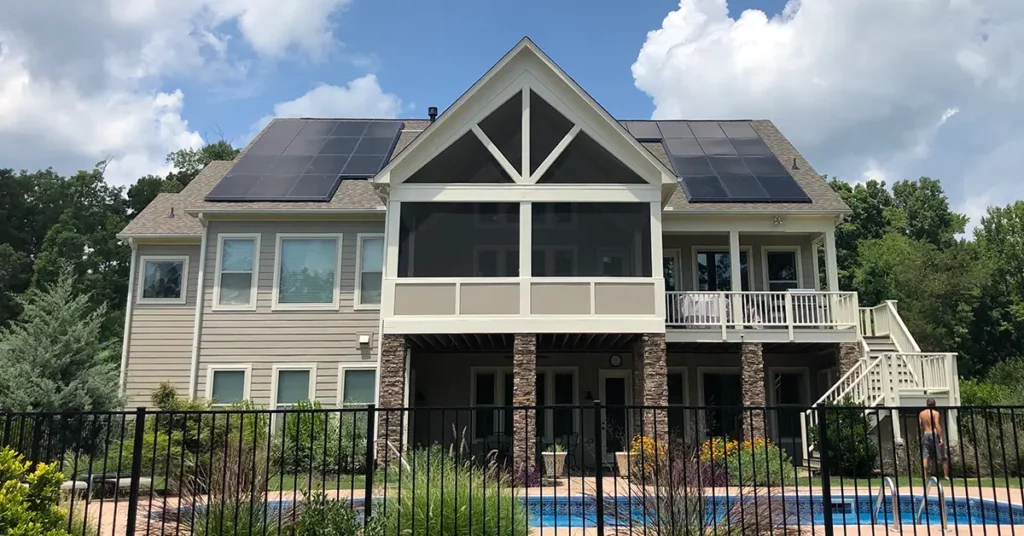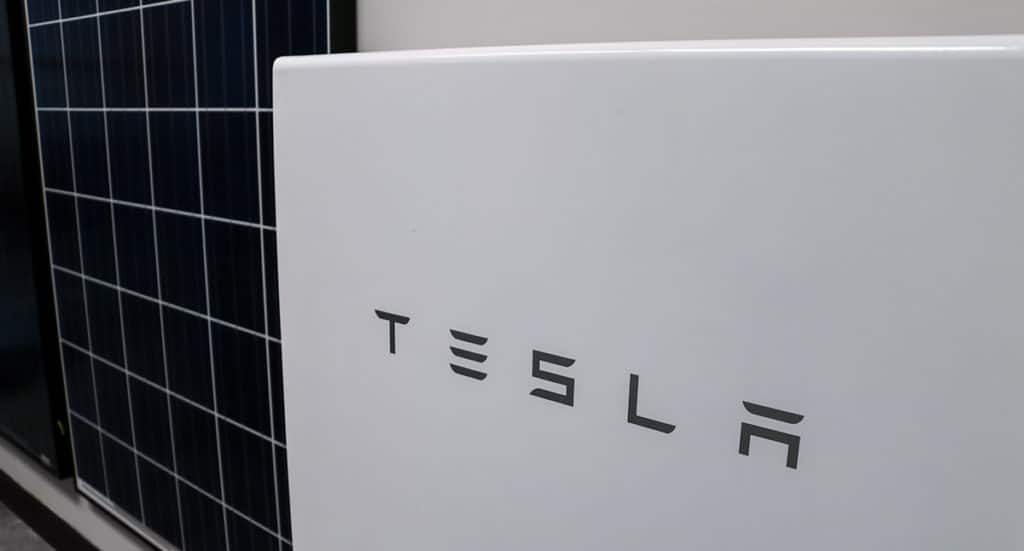How does a solar energy system work?
Solar energy begins with sunlight hitting your solar panels, which creates Direct Current (DC) electricity. That energy flows into your inverter, which converts the DC energy into Alternating Current (AC) electricity that can be used to power your home. The AC energy flows from your inverter to your main electrical panel (or possibly a sub-panel if you have one) and then is used to power all of your home’s lights, appliances, gizmos, and gadgets — anything that uses electricity.
If your solar system is not producing enough energy for your entire home, the utility will fill in the remainder of your energy needs. If your solar system is producing more energy that your home can use, the excess energy will flow out to the grid and your utility will credit you for the power. How much they’ll credit you — at the full retail rate or at their lower “avoided cost” rate — depends on your utility.
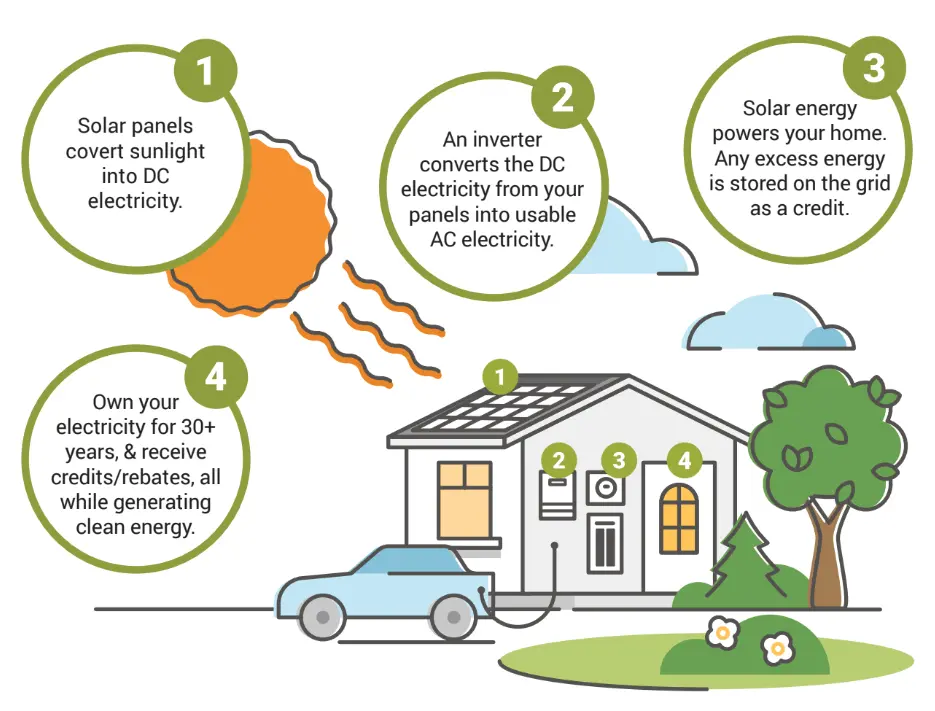
Free Solar Power 101 Guide
How many solar panels do you need to power your home?
We design our solar power systems size based on three main factors:
- Roof size and available space — this tells us the maximum number of solar panels your home or site can hold and, based on the pitch, azimuth (orientation relative to due south), and shading of your roof, how much solar production you can get from each area of your roof. To estimate your solar production, we’ll use satellite imagery or a special camera called a Suneye which takes a 360-degree picture. We’ll run those images through our software which allows us to model your production based on roof pitch, orientation, and shading.
- Energy usage — this helps us hone in on the perfect solar system size for you. We look at 12 months of your utility bills to make sure your system isn’t too big (which risks you donating energy to the utility) or too small (you won’t save enough!).
- Your budget — this is an obvious one! We’ll take your feedback on how much you want to spend and size your system appropriately.
What is solar net metering?
Net metering is a type of utility interconnection policy that controls how your solar system is physically connected to the utility’s grid AND how you are credited for the solar energy you produce. With a net metering policy the utility takes the ‘net’ of your energy consumption versus your solar production.
In traditional net metering, the utility is able to measure the net of your energy usage by installing a special “bi-directional” meter that measures when your solar system sends energy back to the utility’s grid. This happens when your solar system is producing more energy than your home can use at any given moment.
For instance, if your solar system produces 120% of what your home needs, you would send the extra 20% back to the grid, and your meter would register the extra 20% with the utility as a credit. You can use that credit later when your solar system is not producing enough energy for your entire home–at night, for example.
As of 2023, Duke Energy updated its solar net metering structure. It’s a bit more complex, so we have a whole blog dedicated to it →
By allowing you to store any excess solar production as credit, net metering policies effectively turn the grid into a virtual battery for your solar system!
Does Duke Energy offer net-metering?
Yes! Both Duke Energy Carolinas and Duke Energy Progress territories in North Carolina offer net metering for homes with solar.
How do I apply for net-metering?
Each utility has a different application procedure, but having installed 3000+ solar systems across North Carolina, our team is well versed in the various policies across the state. Our team will lead you through that process.
What is the average cost of a home solar system?
Our average home solar panel system is priced between $18,000-$24,000 before any incentives are taken into account. The Federal Tax Credit for solar is currently set at 30%. This credit is available to anyone who pays Federal taxes and can be stretched out up to five years if necessary.
So if your cost was $22,000, subtract 30% ($6600) and you would have a $15,400 solar system. All of our systems are custom designed, so the average price is really that, an average. The price of home solar can range from $10,000 – $100,000 based on your roof, energy usage, goals, aesthetic preferences, battery storage, and budget.
What solar incentives are available in NC?
Good news! The 30% Federal Investment Tax Credit (ITC) for solar was restored in 2022 with the signing of the Inflation Reduction Act. The ITC is set to decrease to 26% in 2032. This incentive is available to homes and businesses, as well as nonprofits (through the new direct pay reimbursement).
For customers in Duke Energy territory, you may be eligible for the PowerPair Incentive Program which offers up to $9,000 in savings on a new solar + battery system. This is a limited time program, so get in touch with us today to make sure we can get your application in as soon as possible.
There are other solar incentives available to North Carolina businesses, such as the USDA REAP Grant.
How long will it take my solar panels to pay for themselves?
It’s hard to find a solar payback period calculator because there are so many unique factors to each PV system and home.
If you look at your solar investment in a vacuum by itself, the payback period for a home solar system is typically between 8-12 years while a commercial solar system’s payback is normally between 4-7 years. But your solar investment won’t live in a vacuum and there are a few other factors that should be considered when evaluating the “payback” period for your system.
First, a solar system is not just an expense, it’s an asset. It add value and equity to your home or business. National and North Carolina specific studies show that solar appraises at approximately 2/3 of its turnkey price. Appraisals are of course market specific, but solar will add some value to your home and that should be taken into account in your payback calculations. Additionally, homes with solar tend to spend less time on the market than “comps” without solar.
Another factor to consider is that there is a cost of doing nothing; of not switching to solar. If you don’t invest in a solar system, you’ll continue to pay the utility each month and electricity prices are only expected to go in one direction. If you compare your solar savings vs the cost you would have paid to the utility, your break-even point is much shorter.
Another way to look at this is that you are currently renting your power from the utility and rent prices are going up. By investing in solar you will own your power. There are costs to make the jump from renting to owning, but the benefits of owning win out quickly and you’ll continue to reap the benefits for more than 30 years.
How does shade affect my solar panels’ production?
Shading is solar’s arch-nemesis. Too much shading can make a solar system infeasible for a location. Sometimes shading issues are really easy to identify, for instance, if we can’t see your roof on Google Maps, shading is probably going to prohibit you from going solar.
Most of the time, we’ll be able to give you a rough idea of whether or not your home is too shaded based on satellite imagery. Sometimes it’s hard to tell the exact shading concerns from a satellite view. In these cases, we use a special device called a Suneye to measure your site’s shading. The Suneye has a fished-eyed lens that we use to take a 360-degree picture from each corner of your roof. We plug those pictures into some nifty software that analyses the images versus the sun’s path throughout the year. From this analysis, we can give you a very accurate solar production estimate–one that we’ll guarantee.
Pro Tip: Planning to take down a worrisome pine tree? No problem! The Suneye and satellite technology allows us to model the removal of trees and other shading obstructions.
At the end of the day, if your solar site is more than 50% shaded throughout the course of the year we’ll normally advise you to not go solar and enjoy your beautiful trees. Between 50-70% shading is generally workable and upwards of 70% we aren’t concerned about your shade!
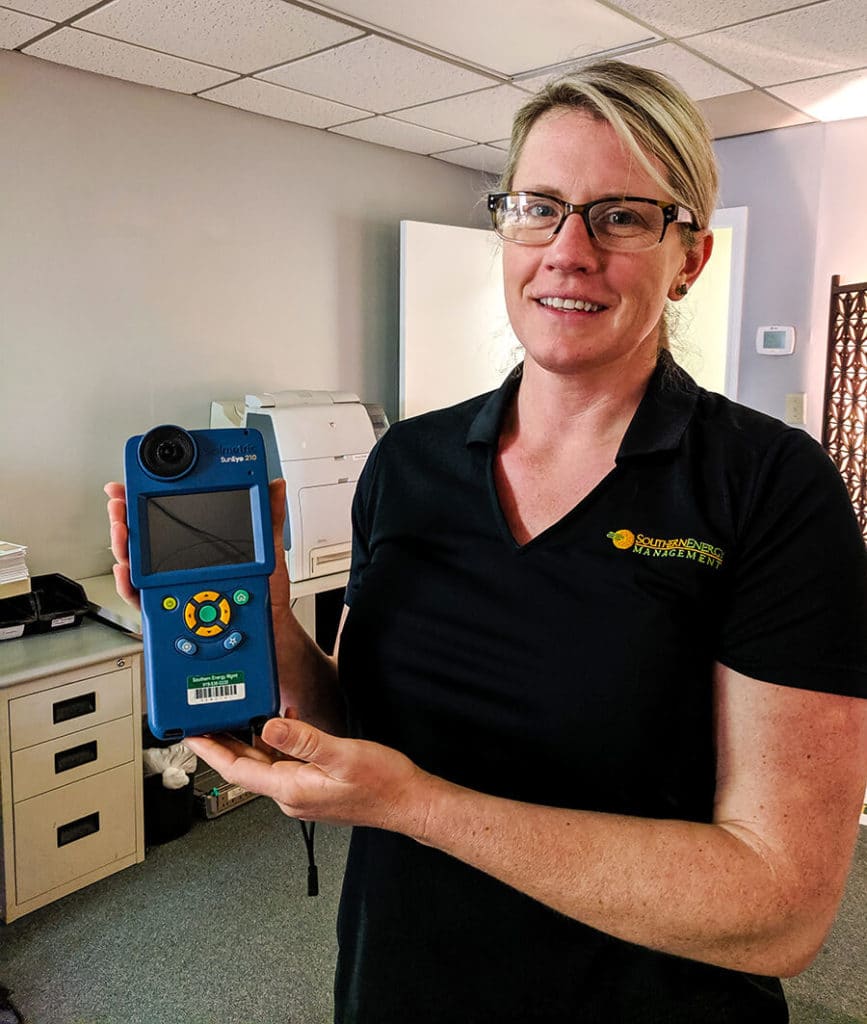
Do solar panels work when the power goes out?
By default, your solar system will not produce energy during a power outage. This is one of the most common (and understandable) misconceptions about a home solar system. However, federal regulations require that your solar panels automatically shut-off during a power outage.
This requirement protects utility linemen who could be injured if they are working to repair power lines that are being fed live power by your home solar system. Since your home (and thousands of other solar homes) is a power producer, shutting the panels off is the only way to guarantee a safe environment for the line-workers.
If your main goal is to have backup power during an outage, adding a battery back-up system like a Tesla Powerwall is the best way to have a sustainable, intelligent power source to help you weather the storm.
Do I need to replace my roof before going solar?
If you’re going to replace your roof in the next 5-7 years you should wait to go solar until after your new roof is in place. If your roof is new or mid-life, now’s a great time to go ahead and get solar.
When you do need to re-roof, it’s easy to take the panels down once the racking is in place! The racking mechanisms we use allow us to easily pop the panels on and off. The cost of removing and reinstalling your panels will depend on your home and the size of your system. An average estimate ranges from $4-6K for a typical home.
Will the panel installation cause leaks?
Our install crews minimize the penetrations in your roof, but they do have to screw in to the joists to secure the panels. We flash around all roof penetrations to prevent leaks. If there is a leak, our 5 year workmanship warranty would cover it.
How will the solar panels affect my roof?
Fun Fact: Panels actually protect the roof underneath them because the roof is not directly exposed to the elements — wind, rain, snow, and sun!
How long does a typical home solar install in NC take?
The typical installation timeline for a residential install is 2-3 days on site, with the whole process from start to finish taking approximately 90 days.
About half of that time is taken for engineering and design, permitting with your local jurisdiction, the interconnection application with your utility, procuring material etc. Then after installation, an inspection is required and once passed, we all have to wait 20-30 days for your new bidirectional meter to be installed by the utility. Once your meter is installed, we’ll come turn your system on, show you how it operates, and you’ll start saving!
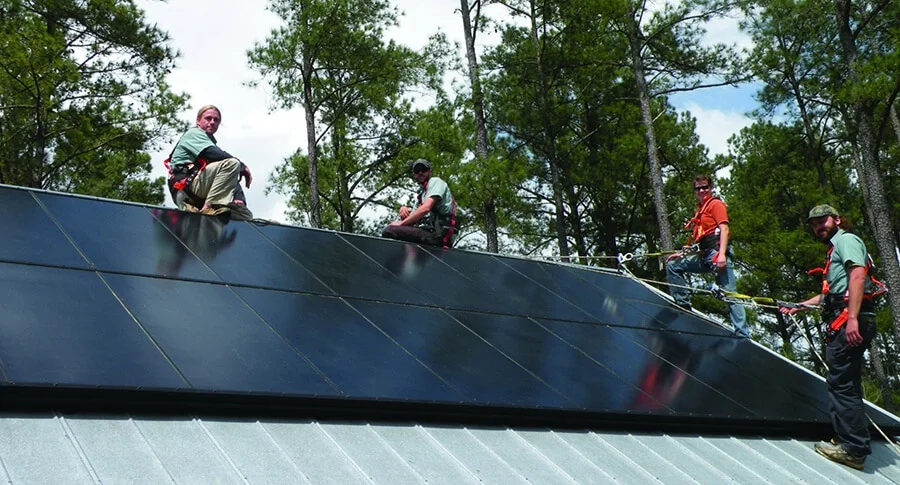
Ready to Get Started?
Schedule a free assessment to learn more about solar power & battery storage for your home.
About Us
North Carolina’s solar power and building performance expert. Founded in 2001, we’ve worked for 20+ years to improve the way people make and use energy.

